heating AUDI A4 AVANT 2008 Owners Manual
[x] Cancel search | Manufacturer: AUDI, Model Year: 2008, Model line: A4 AVANT, Model: AUDI A4 AVANT 2008Pages: 368, PDF Size: 46.19 MB
Page 13 of 368
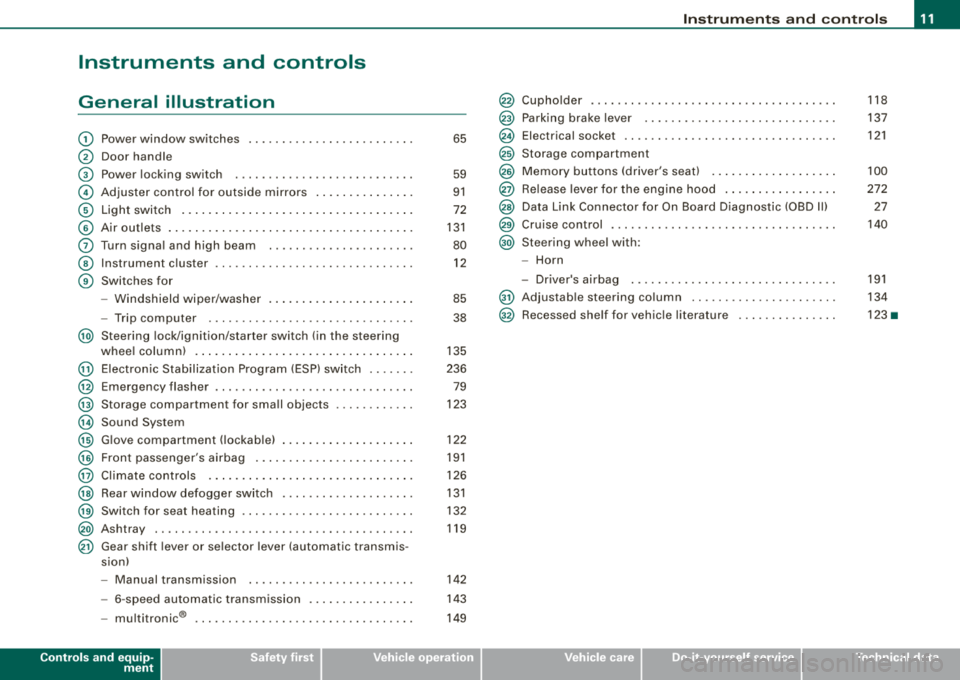
Instruments and controls
General illustration
G) Power window switches ........................ .
0 Door handle
G) Power locking switch .......................... .
© Adjuster control fo r outside mirrors ...... .... .... .
© Light switch .. ...... .... ... .... .... .... .... ... .
© Air o utlets ........ ... .. .... .... ... .... .... .... .
0 Turn s igna l and high beam .. .... .... ......... .. .
© Instrument c luster .. ... .... .... .... ... .. .... ... .
G) Switches for
- Windshield wiper/washer . ...... .... .... ... ... .
- Trip computer ...... .... .... ... .... .... .... . .
@ Steering lock/ignition/starter switch (in the steering
@
@
@
@
@
@
@
@
@
@
@
whee l column) . ...... ... .... .... .... ... .... ... .
Electron ic Stab ilization Prog ram (ESP) switc h ...... .
Emergency flasher ....... .... .... .... .... .... .. .
Storage compartment for sma ll objects
Sound System
G love compartment ( lockab le) ... .. .... .... .... .. .
Front passenger's airbag .... .... .... .... ..... .. .
Cl imate controls .. ..... .... .... ...... .... ... .. .
Rear window defogger switc h .... .... .... .... ... .
Switch for seat heating ......................... .
Ashtray .. ....... .... ............. ...... .... .. .
Gear shift lever or selector lever (automatic transmis
s ion)
- Manual transmission .. ...... ....... ...... ... .
- 6-speed automa tic transm ission .. ...... .... ... .
I .
.
® -mu t1tronic ................................ .
65
59
91
72
131
80
12
85
38
135
236 79
123
122
191
126
131
132
119
142
1 4 3
14 9
Controls and equip
ment • I I • • I
Instrum ents and controls
Cupho lder
Park ing brake lever ............................ .
Electrical socket ............................... .
Storage compartment
Memory buttons (driver's seat) .. ...... .... ... ... .
Re lease lever for t he e ngine hood ...... .... ... ... .
Data Link Connector fo r On Board D iagnostic (OBD Ill
Cruise control .... .... .... .... ....... .... .... .. .
Steering wheel with:
- Horn
D. ' . b - nversa1r ag . ................ .... ......... .
@ Adjustab le steering co lumn .. ...... .... .... .... . .
@ Recessed she lf for vehic le literature .............. .
118
137
121
100
272 27
140
191
134
123 •
Page 112 of 368
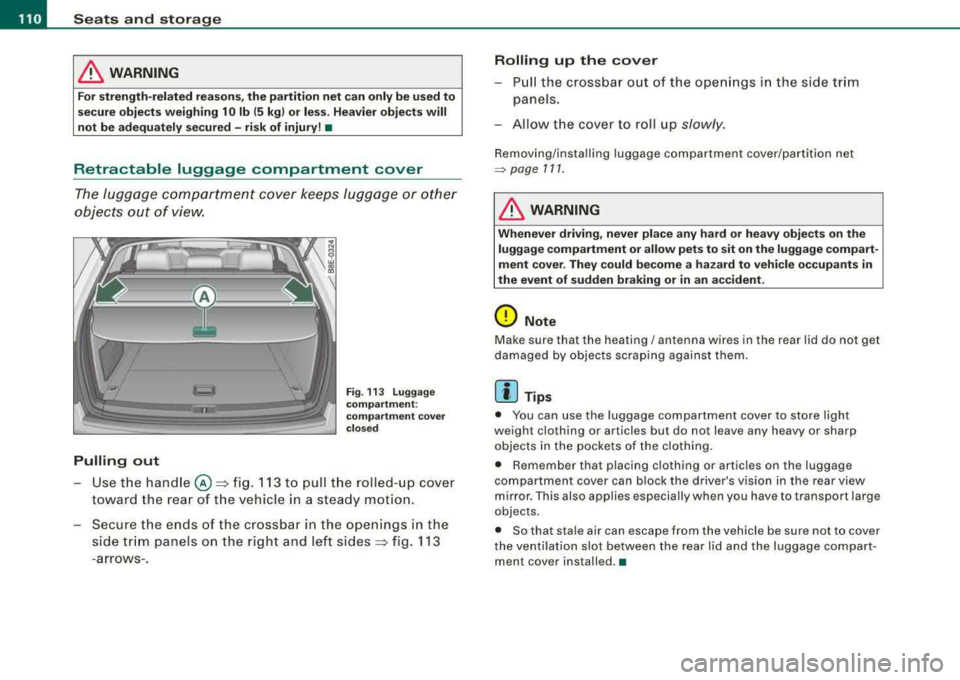
___ S_ e
_ a_t_s _ a_n_ d
__ s _t _o _r_a ...::g==---- e ________________________________________________ _
& WARNING
Fo r st rength -related r easons, th e partition net can o nly be us ed to
s ecure object s weigh ing 10 lb (5 kg ) or le ss. Heavier objects will
not be adequ atel y sec ured -risk of i njury ! •
Retractable luggage compartment cover
The luggage comp artment cover keeps luggage or other
objects out of view.
Pulling out
Fi g. 113 Lugga ge
co mp art m ent:
co mp artm ent c over
c lo se d
- Use t he hand le @ ~ fig. 11 3 to pull the rolled- up cover
toward the rear of t he veh icle in a steady mot ion.
- Secure the en ds of the crossbar in the o penings in the
s ide tr im panels on the right and left
sides ~ fig. 113
-arrows-.
Rolling up th e cov er
- Pull the crossbar out of the ope nings in the side trim
panels.
- Allow the cover to roll up
slowly.
Removing /insta lling luggage compartment cover/partition net
~ page 111.
& WARNING
Whenev er dri vin g, ne ver pl ace any h ard or heavy ob ject s on th e
luggage comp art m ent or allow p ets to sit on the luggage compart
m ent c over. They could become a hazar d to vehic le occupant s in
the e vent of sudden bra king or in an a ccident.
0 Note
Make sure that the heating/ antenna wires in th e rear lid do no t get
damaged by objects scraping against them.
[ i ] Tips
• You can use the luggage compartment cover to store light
weight clothing or ar ticles bu t do not leave any heavy or sharp
objects in the pockets of the clothing .
• Remember that placing c lothing or articl es on the luggage
compartment cover can block the driver 's vis ion in the rear view
mirror. This also applies especially when you have to transport larg e
objects .
• So that sta le air can escap e from the vehicle b e sure not to cov er
the venti lation slot between the rear lid and the luggage compart
men t cov er ins talled. •
Page 127 of 368
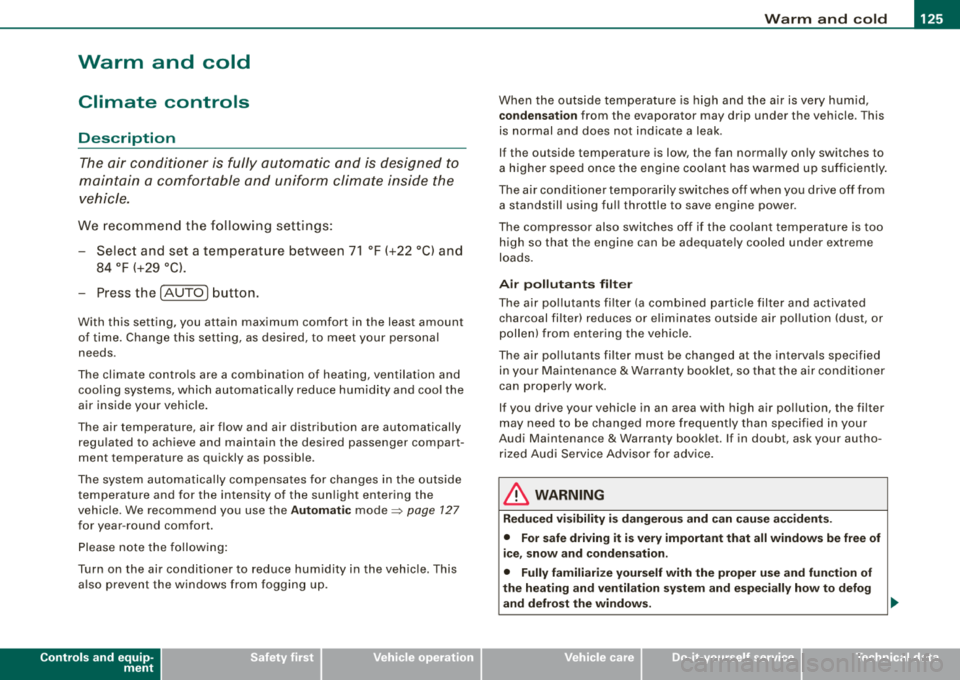
Warm and cold -
----------------
Warm and cold
Climate controls
Description
The air conditioner is fully automatic and is designed to
maintain a comfortable and uniform climate inside the
vehicle.
We recommend the fo llowing settings:
- Select and set a temperature between 71 °F (+22 °C) and
84 °F (+29 °C).
- Press the [AUTO
I button.
With this setting, you attain maximum comfort in the least amount
of time . C hange this sett ing, as des ired, to meet your personal
needs .
The climate contro ls are a combination of heating, ventilation and
cool ing systems, which automatica lly reduce humidity and coo l the
air inside your vehicle .
The air temperature, air flow and air distribution are automatically
regu lated to achieve and maintain the desired passenger compart
ment temperatu re as quickly as possible.
The system automatically compensates for changes in the outside
temperature and for the intensity of the sunlight entering the
veh ic le. We recommend you use the
Automati c mode=> page 127
for year-round comfort.
Please note the follow ing :
Turn on the air conditioner to reduce hum idity in the veh ic le. This
a lso prevent the windows from fogging up.
Controls and equip
ment
When the outside temperature is high and the air is very humid,
c o ndensat ion from the evaporator may drip under the vehicle. This
is normal and does not ind icate a leak.
If the outside temperature is low, the fan norma lly on ly switches to
a higher speed once the engine coolant has warmed up suff iciently .
The air conditioner temporarily switches off when you drive off from a standstill using ful l throttle to save engine power.
The compressor also switches off if the coolant temperature is too
high so that the engine can be adequate ly cooled under extreme
loads .
Air p ollut ants filt er
The air po llutants fi lter (a combined part ic le filter and activated
charcoal filter) reduces or e liminates outside air pol lution (dust, or
pollen) from enter ing the vehic le .
The air po llutants filter must be changed at the intervals specified
in you r Maintenance
& Wa rranty booklet, so that the air cond itioner
can proper ly work.
If you drive your vehic le in an area with high air pol lution, the filter
may need to be changed more frequently than speci fied in your
Audi Maintenance
& Warranty book let. If in doubt, ask your autho
ri zed Aud i Service Adv isor fo r advice .
& WARNING
Reduced vi sibility i s da ng erou s and can cause accident s.
• For safe driving it is very important that all windows be free of
ice , snow and cond ensa tion .
• Fully familiarize yourself with the proper us e and function of
the heating and ventilation sy stem and e speci ally how to defog
and defrost the window s.
...
Page 130 of 368
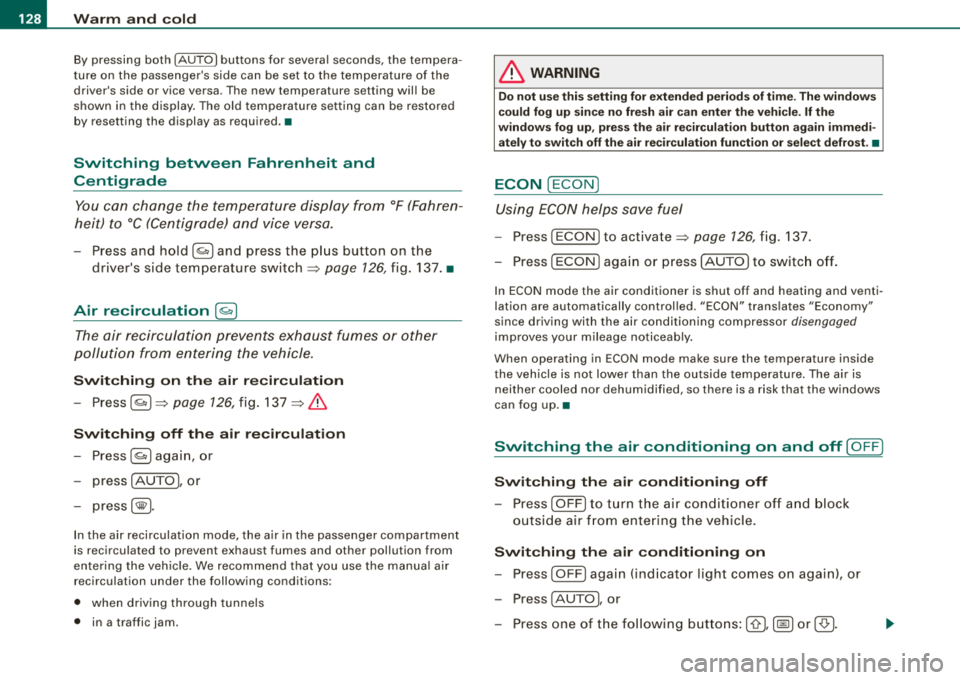
_L_W:...:._: a::..:_: rm:....:...:..~ a::..: n~ d~ c~o :.:l.:::d :.._ _______________________________________________ _
By pressing both !AUTO l buttons for several seconds, the tempera
ture on the passenger's side can be set to the temperature of the
driver's side or vice versa . The new temperature set ting will be
shown in the display. The old temperature setting can be restored
by resetting the display as required. •
Switching between Fahrenheit and
Centigrade
You can change the temperature display from °F (Fahren
heit) to
°C (Centigrade) and vice versa.
- Press and hold[ ~] and press the plus button on the
driver's side temperature
switch ~ page 126, fig. 137 . •
Air recircul ation [~]
The air recirculation prevents exhaust fumes or other
pollution from entering the vehicle.
Switching on the air recirculation
-Press[ ~]~ page 126, fig. 137 ~ &
Switching off the air recirculation
-Press~ again, or
- press [AUTO], or
press[ ®].
In the air recirculation mode , the air in the passenger compartment
is recirculated to prevent exhaust fumes and other pollution from
entering the vehicle. We recommend that you use the manual air recirculation under the following conditions:
• when driving through tunnels
• in a tra ffic jam.
& WARNING
Do not use this setting for extended periods of time . The windows
could fog up since no fresh air can enter the vehicle.
If the
windows fog up, press the air recirculation button again immedi ately to switch off the air recirculation function or select defrost. •
ECON [ECON]
Using ECON helps save fuel
- Press [ECON] to activate ~ page 126, fig. 137.
Press [ECON] again or press [AUTO] to switch off.
In ECON mode the air conditioner is shut off and heating and venti
lation are automatically controlled . "ECON" translates "Economy"
since driving with the air conditioning compressor disengaged
improves your mileage noticeably.
When operating in ECON mode make sure the temperature inside
the vehicle is not lower than the outside temperature. The air is
nei ther cooled nor dehumidified, so there is a risk that the windows
can fog up .•
Switching the air conditioning on and off [ OFF]
Switching the air conditioning off
-Press [ OFF] to turn the air conditioner off and block
outside air from entering the vehicle.
Switching the air conditioning on
-Press [ OFF] again (indicator light comes on again), or
- Press [AUTO], or
- Press one of the following buttons:
[O J,[@!] or [-0, ].
Page 135 of 368
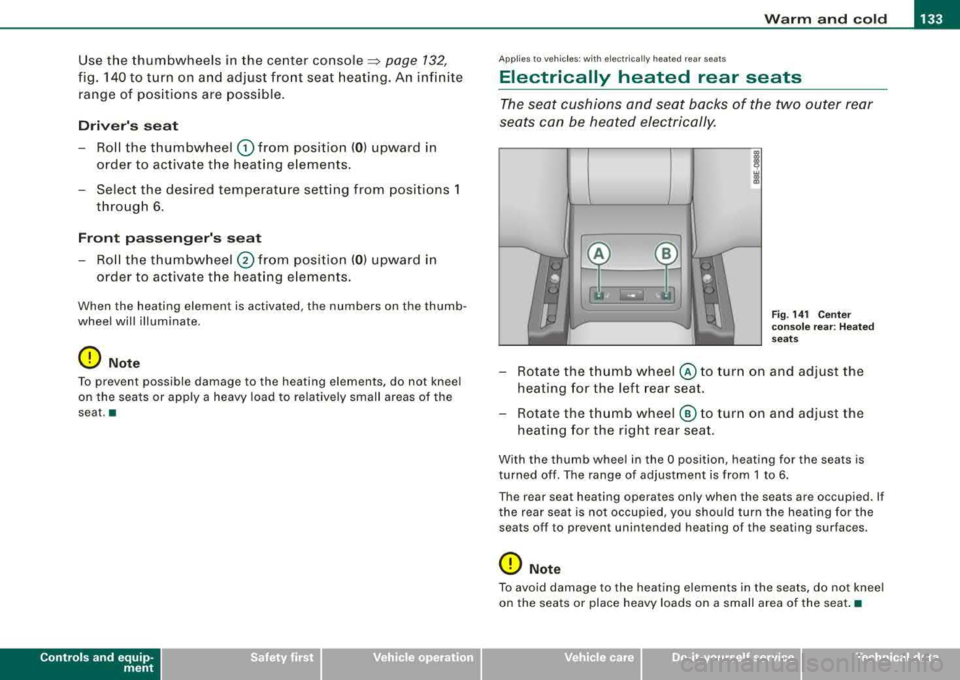
Warm and cold -
-----------------'
Use the thumbwheels in the center conso le ::::::, page 132,
fig. 140 to turn on and adjust front seat heating. An infinite
range of pos itions are possible.
Driv er's s eat
Roll the thumbwheel G) from pos ition ( 0 ) upward in
order to activate the heating elements .
- Select the desired temperature setting from posit ions 1
through 6 .
Front pass eng er's se at
- Roll the thumbwheel 0 from pos ition ( 0 ) upward in
order to activate t he heating e lements .
When the heating element is activated, the numbers on the thumb
wheel will illum inate .
0 Note
To preven t possible damage to the hea ting elemen ts, do not kneel
on the seats or apply a heavy load to relative ly small areas of the
sea t.•
Controls and equip
ment
A pp lies to veh ic les: w ith e lectrically heated rea r seats
Electrically heated rear seats
The seat cushions and seat backs of the two outer rear
seats can be heated electrically .
Fig. 14 1 C enter
co nso le re ar: H ea ted
seats
- Rotate the thumb wheel © to turn on and adjust the
heating for the left rear seat.
- Rotate the thumb wheel ® to turn on and adjust the
heating for the right rear seat .
With the thumb wheel in the O position, heating for the sea ts is
turned off . The range of adjustment is from 1 to 6.
Th e re ar seat heating operat es only when the seats ar e occupied. I f
the rear seat is not occupied, you should turn the heating for the
sea ts o ff t o preven t unint ended heating of th e seating surfac es.
0 Note
To avoid damage to the heating elemen ts in the sea ts, do not kneel
on the seats or place heavy loads on a small area of the seat .•
irechnical data
Page 240 of 368

-Intelligent technology
------~----- ~~--------------------------------------
one side), the spinning wheel is braked, thereby transferring power
to the other drive wheel or wheels (all- wheel drivel. This is done up
to a speed of about 60 mph (100 km/h). Noises from the brake
system signal that wheel spin is being control led.
Driving off
When driving off, always be sure to keep road conditions in mind as
you accelerate. If one drive wheel spins because it is on a surface
with less grip, gradual ly increase the pressure on the accelerator
pedal until the car starts to move. The wheel less able to transfer
power spins.
Overheating of brakes
To prevent the disc brake of the braked wheel from overheating if
subjected to excessive loads, the EDL cuts out temporarily. The
veh ic le remains operational and behaves in the same way as a
vehic le without EDL.
As soon as the brake has cooled down, EDL switches on again auto
matically.
& WARNING
• When accelerating on slippery surfaces, such as on ice or snow,
always be careful when depressing the accelerator pedal. Even
with the EDL working, the drive wheels can spin and reduce your
ability to control your car . - Risk of crash!
• The increased safety afforded by EDL does not mean that you
ca n take safety risks. Always adapt your driving style to the road
conditions and traffic situation.
[ i ] Tips
If a fault occurs in the ABS, the EDL is also not functioning. This is
indicated by the ABS warning
light => page 21. •
Anti-Slip Regulation System (ASR)
The Anti-Slip Regulation System prevents the driven
wheels from spinning when the car is accelerating.
General notes
The Anti-Slip Regulation System (ASR) is integrated in the electronic
stabilization program (ESP) . When the vehicle starts up and acceler
ates, the wheels are prevented from sp inning by adjus tin g the
engine power to match the amount of grip availab le from the road
surface.
How the system works
ASR performs automatical ly, i.e . w ithout the driver's intervention.
With the aid of the ABS
sensors=> page 240, ASR monitors the
speed of the driven wheels. If the wheels start to spin, the engine
power is reduced automatically until the tires find enough grip to
lock onto the road surface. The system is active across the entire
speed range.
The ASR works in conjunction with the ABS. If a malfunction shou ld
occur in the ABS, the ASR will also be out of act ion.
Activation
The ESP is automatica lly activated when the eng ine is started, and
it performs a self-test. You can activate a deactivated ASR, if
requ ired, by pressing
t h e=> page 236, fig . 199 button .
Deactivation
You can deactivate the ASR, if required, by pressing the button (for
less than 3
seconds) => page 236, fig. 199. With the ASR deactivated,
the ESP check light flashes,
see=> page 22.
Normally, the ESP shou ld always be on, however, it may be advanta
geous to turn off the system in certai n special cases when some
degree of wheel spin is desired such as :
• when driving with snow chains
Page 246 of 368
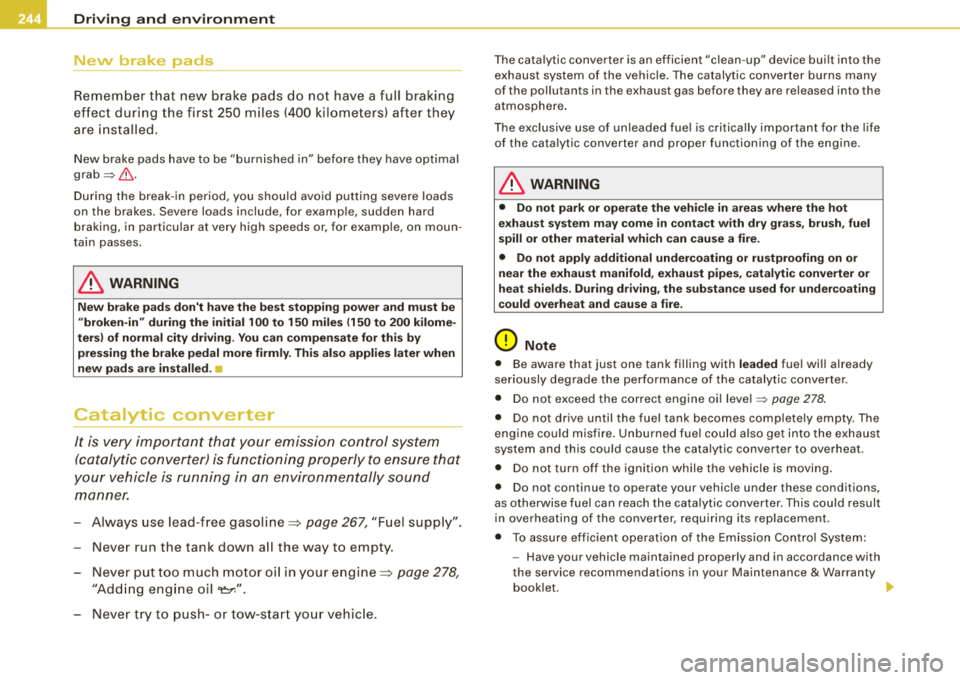
llffll.,__ __ D_r_ iv _ in_.... g,_ a_n_ d __ e_n _v_ ir_o_ n_ m_ e_n_ t _____________________________________________ _
New brake pads
Remember that new brake pads do not have a full braking
effec t during the first 250 miles (400 kilometers) after they
are i nstalled .
New brake pads have to be "burn ished in" befo re they have opti mal
grab =>& .
During the break -in period, you s hou ld avo id putti ng severe loads
on the brakes . Severe loads include, for examp le, sudden hard
braking, in particular at very h igh speeds or, for example, on moun
t ain passes .
& WARNING
New brake p ad s don't h ave th e be st sto pping p ower a nd mu st b e
" brok en -in " durin g th e initial 100 to 1 50 mil es (150 t o 200 kil ome
t e rs) of norm al cit y dri ving . You can comp en sa te for thi s by
pr ess ing the brak e ped al mor e firmly . Thi s al so appli es later when
ne w pad s a re in sta lled. •
Catalytic converter
It is very important that your emission control sys tem
(catalytic conver ter) is functioning properly to ensure that
y o ur vehicle is running in an environmentally sound
manner.
-Always use lead-free gasoline => page 267, "Fuel supply".
-Never run the tank down a ll the way to empty.
-Never put too much motor o il in your engine => page 278,
"Add ing eng ine oil
The catalytic converter is an efficient "clean-up " device built into the
exhaust system of the vehicle. The catalyt ic converter burns many
of the po llutants in the exhaust gas before they are released into the
atmosphere.
T he exc lusive use o f un leaded fue l is critica lly important for the l ife
of the catalytic converter and proper functioning of the engine.
& WARNING
• Do not park or operate th e veh icle in ar eas wh ere the hot
ex hau st sys tem m ay come in contac t w ith dr y gra ss, bru sh , fuel
s pill or other material which can cau se a fire .
• Do not appl y additi ona l under coating or ru stpr oofing on or
ne ar the e xhau st m anifol d, ex haust pipe s, ca ta lytic converter or
he at shield s. Du ring dri ving , the sub sta nce u sed f or under coating
c ould overhe at and cau se a fir e.
0 Note
• Be aware that just one tank filling with leaded fue l wi ll already
ser iously degrade the performance of the catalyt ic converter.
• Do not exceed the correct engine oi l
level=> page 278.
• Do not drive until the fuel tank becomes comp letely empty . The
engine could misfire . Unburned fuel could also get into the exhaust
system and this could cause the catalytic conver ter to overheat .
• Do not turn off the ignition wh ile the vehicle is moving.
• Do not continue to operate your vehicle under these conditions,
as otherwise fuel can reach the cata lyt ic converter . This cou ld result
in overheating of the converter, requiring its rep lacement .
• To assure eff icient operat ion of the Em iss ion Control System:
- Have your vehicle maintained properly and in accordance with
the service recommendations in your Maintenance
& Warranty
booklet.
..,
Page 248 of 368

lffll.,__ __ D_r_ i_v _i_n _.g..,_ a_ n_d_ e_ n_v _ i
_ r_o _ n_ m_ e_ n_ t _______________________________________________ _
one half. Never drive faster than the posted speed limit and weather
conditions permit. •
Reducing unnecessary idling
Even when your car is just idling it burns up fuel.
- Shut the engine off when you are not driving the vehicle .
- Do not warm up the vehic le by letting the engine run at
id le .
It makes sense to shut off the engine in traff ic jams, when waiting
for tra ins to pass at rai lroad crossings , or at traffic lights that have
long waits on red. Turning the engine off for just 30 -40 seconds
saves more fue l than is burned starting the engine again .
It takes a long time for the engine to warm up fu lly when it is
running at idle. However, wear and noxious emiss ions are espec ially
high when the engine is warming up . So you should drive away as
soon as you sta rt the engine and avoid running at high rpms w hile
the engine is sti ll warming up.
0 Note
Do not leave engine idling unattended after starting . If warning
lights should come on to indicate improper operation, they would
go unheeded. Extended id ling also produces heat, which could
resu lt in overheating or other damage to the vehic le or other
property .•
Regular maintenance
A badly tuned engine unnecessarily wastes a lot of fuel.
- Have your ve hicle serviced at regular intervals .
By having your vehicle regularly serviced by an Audi dealer helps to
ensure that it runs properly and economical ly . The cond ition of your
vehic le not only affects its safety and abi lity to hold its value, it also
affects
fuel consumpt ion .
Check your oil ea ch time you fill your t ank .
The amount of oil used is related to engine load and speed.
I t is norma l for the oi l consumption of a new engine to reach its
lowest value after a certain mi leage has been driven.
You must drive your vehicle about 3,000 miles (5,000 kilometers) before you can properly assess oil consumption .
This also applies to fue l consump tion and engine output .
0 Note
• Have your vehicle maintained properly and in accordance with
t he service recom mendat io n s in your Maintenance
& Wa rranty
booklet. Lack of proper ma intenance as well as improper use of the
vehic le wi ll impai r the function of the emission cont rol system and
cou ld lead to damage.
• Do no t alte r or remove any component of the Emission Contro l
System unless approved by the manufacturer .
• Do not alte r or remove any dev ice, such as heat shields,
switches, ignition wires, valves, which are designed to protec t your
vehic le's Emission Control System and other important veh ic le
components .•
Fewer short trips
Fuel consumption will alw ays be rel atively high on short
t r ips.
- Try to avo id driving short dis ta n ces wi th a cold engine. ~
Page 267 of 368

_______________________________________________ C_l_ e _a_ n_ in---= g'-- a_n_ d
_.:.. p_r_o _ t_ e_ c_ t·_
1o _ n __ l9III
Safety belts
Only well-maintained safety belts work reliably when
needed.
- Keep belts clean.
- For cleaning, use a mild soap and water solution. Let
belts dry thoroughly and away from direct sunlight.
- Do not allow inertia reel safety belts to retract before
they are completely dry.
- Check the condition of your safety belts
regularly.
Heavily soiled safety belts may not retract properly.
& WARNING
Damaged safety belts can break in a crash.
• Anything that might damage your safety belts could mean that
you and your passengers would not be adequately protected in an
accident.
• Safety belt performance depends on correct installation. Never
remove belts from the vehicle to clean them.
• Do not use chemical cleaning agents, bleach or dyes. They have
corrosive properties which weaken the webbing.
• When cleaning your safety belts, inspect them for damage. If
you discover damage, see your Audi dealer.
• Always read and heed all WARNINGS and the information
=> page 254. •
Engine compartment
Be especially careful when cleaning the engine compart
ment.
Always switch off the ignition before cleaning the engine => &.
Plenum panel
Remove leaves from the plenum panel in front of the windshield
under the engine hood. This prevents the water drain holes from
becoming blocked, and it prevents debris from entering the vehicle
interior through the heating and ventilation ducts .
Corrosion protection
The engine compartment and transmission have been corrosion
protected at the factory.
Good anti-corrosion treatment is very important, particularly in the
winter. If the vehicle is frequently driven on salt treated roads, the
entire engine compartment and plenum panel should be thor
oughly cleaned at the end of winter and retreated to prevent salt
damage. At the same time, the underside of the vehicle should be
washed as well.
If the engine compartment is cleaned at any time with grease
removing solutions
21 , or if you have the engine washed , the anti
corrosion treatment is almost always removed as well. It is therefore
essential to have a long-lasting corrosion protection reapplied to all
surfaces, seams, joints and components in the engine compart
ment.
& WARNING
Be aware: the engine compartment of any motor vehicle is a
potentially hazardous area.
• Before working in the engine compartment, be sure to read the
information
=> page 265 . .,,_
21 Use only the corr ect cleaning solutions. Never use gasoline or diesel fuel.
Vehicle care
Page 283 of 368

_____________________________________________ C_h_ e_ c
_ k_in -= g_a
_ n_d _ f_il _li _n ..;::g ;;.___..
le as t 50 % but not more th an 60 % to maintain antifreeze protection
and cooling efficiency . If the coolant frost protection is too low, the
coolant could freeze and damage the vehic le heating and engine
cooling system.
For year -round driving, antifreeze is added at the factory for temper
atures down to :
•
-31 °F (- 35 °C) USA
•
-40 °F ( -40 °C) Canada.
You can mix the G12 + coolant additive with other additives (for
examp le G11 or G12) . Always check with your authorized Audi
dea ler.
& WARNING
Bef ore you check anything in the eng ine comp artm ent , a lw ays
re ad and h eed all W ARNING S
=> & in "Worki ng in the engine
c ompartm en t" on
page 273.
0 Note
• Before winter sets in, have the coolant checked to see if the
coolant additive in your vehicle is sufficient to meet the climate
conditions. This is especially important if you live in a region where
the winter is extremely cold. If necessary, increase the proportion of coolant additive to 60%.
• When adding coolant additive to your cooling system,
remember :
-We recommend using only coolant additive G12 + (check the
label) for your vehicle. This coo lant additive is avai lable at autho
rized Audi dealers . Other types of antifreeze can significantly
reduce corrosion protect ion. The resulting corrosion can cause a
loss of coolant and serious engine damage.
• Do no t add any type of radiator leak sealan t to you r vehicle's
engine coolant . Adding radiator repair fluid may adversely affect the function and performance of your cooling system and could result
in damage not covered by yo ur New Vehicle Limited Warranty. •
Checking the engine coolant level
The engine coolant level can be checked with a quick
glance.
F ig . 211 E ngine
co mpa rtm ent: Co olan t
e xp an sion tan k
Before you che ck a ny thing in the e ng ine compar tmen t,
alway s read and heed all
WARNINGS => & in "Working in
t h e engine compartment" on
page 273.
Turn off the ignitio n.
Let the engine cool down.
P lace a t hick rag over the coo lant expans ion tank
=> fig. 211 and carefully twist the cap counter-clockwise
=>& . ...
Ve hic le care irechnical data